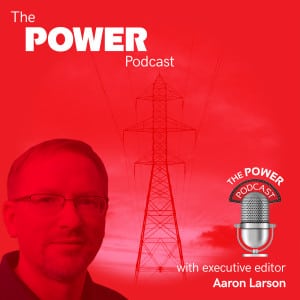The POWER Podcast
-
Full Coverage
Communication Is Key to Successful Power Projects
Power plant construction and retrofit projects come in all shapes and sizes, but they all generally have at least one thing in common: complexity. There are usually a lot of moving pieces that must be managed. This can include sourcing the right materials and components, getting equipment delivered to the site at the right time, […]
-
POWER Podcasts
The POWER Podcast Archive Vol. 7
The POWER Podcast is available through Apple Podcasts, Spotify, YouTube, YouTube Music, Amazon Music, iHeart, TuneIn, SoundCloud, and some other podcast apps. Follow the links below to subscribe via your favorite platform: Apple Podcasts Spotify YouTube YouTube Music Amazon Music iHeart TuneIn SoundCloud The POWER Podcast Archive (Dec. 14, 2023 – Nov. 21, 2024): Communication […]
Tagged in: -
POWER Podcasts
Kingston Coal Ash Spill: Cleanup Workers Were the Unfortunate Losers
On Dec. 22, 2008, a major dike failure occurred on the north slopes of the ash pond at the Tennessee Valley Authority’s (TVA’s) Kingston Fossil Plant. The failure resulted in the release of approximately 5.4 million cubic yards of coal ash spilling onto adjacent land and into the Emory River. The Kingston spill is considered […]
-
Sustainability
Why Data Center Developers Should Think ‘Power First’
You don’t need me to tell you how artificial intelligence (AI) is impacting the power grid; you can just ask AI. Claude, an AI assistant created by Anthropic, told POWER, “AI training and inference are driving unprecedented demand for data center capacity, particularly due to large language models and other compute-intensive AI workloads.” It also […]
-
Nuclear
What Are Microreactors and How Soon Could We See One in Operation
Microreactors are a class of very small modular reactors targeted for non-conventional nuclear markets. The U.S. Department of Energy (DOE) supports a variety of advanced reactor designs, including gas, liquid-metal, molten-salt, and heat-pipe-cooled concepts. In the U.S., microreactor developers are currently focused on designs that could be deployed as early as the mid-2020s. The key […]
-
Gas
Experts Say Gas-Fired Power Key to Reliable U.S. Electricity Supply
Energy analysts have said the increasing need for reliable baseload power generation means natural gas-fired power plants will become even more important as demand for electricity increases. Several experts who have spoken with POWER noted the availability of natural gas—the U.S. leads the world in natural gas production, far outpacing second-ranked Russia—will drive continued construction […]
-
Solar
Understanding the Domestic Content Bonus Credit and How to Maximize Incentives for Solar Projects
In May, the U.S. Department of the Treasury and IRS released additional guidance on the Inflation Reduction Act’s (IRA’s) domestic content bonus, part of President Biden’s economic strategy to boost American manufacturing, and iron and steel production. The domestic content bonus credit is available to taxpayers that certify their qualified facility, energy project, or energy […]
Tagged in: -
Sustainability
Fuel Cells: What They Are, How They Work, and Why They’re Important
Fuel cells are not some novel new technology. In fact, most history books credit the invention of the fuel cell to Welsh chemist and physicist William Grove, who, in the late 1830s and early 1840s, conducted experiments proving that electric current could be produced from an electrochemical reaction between hydrogen and oxygen over a platinum […]
-
Nuclear
Analyst Says Nuclear Industry Is ‘Totally Irrelevant’ in the Market for New Power Capacity
Nuclear power has consistently provided about 19% to 20% of total annual U.S. electricity generation since 1990. It provides significant amounts of electricity in many other countries as well. According to data from The World Nuclear Industry Status Report (WNISR), a total of 414 reactors were operating in 32 countries, as of July 1, 2024. […]
-
T&D
U.S. Power Distribution System Reliability Has Declined Over the Past Decade: How to Make It Better
SAIDI (System Average Interruption Duration Index) and SAIFI (System Average Interruption Frequency Index) are widely used reliability indices that measure the performance of power distribution systems. SAIDI represents the total duration of interruptions for an average customer over a given time period, typically a year. It is calculated by taking the sum of all customer […]










